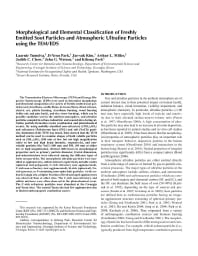Mining Publication: Morphological and Elemental Classification of Freshly Emitted Soot Particles and Atmospheric Ultrafine Particles using the TEM/EDS
Original creation date: March 2010
Authors: L Tumolva, J Park, J Kim, AL Miller, JC Chow, JG Watson, KH Park
The Transmission Electron Microscopy (TEM) and Energy Dispersive Spectroscopy (EDS) were used to determine morphology and elemental composition of a variety of freshly emitted soot particles (acetylene flame, candle flame, kerosene flame, diesel exhaust, electric arc, plastic burning, styrofoam burning, wood burning [white oak and pine bark], and rice straw burning), which can be possible candidate soot in the ambient atmosphere, and ultrafine particles sampled in urban, industrial, and coastal sites during ultrafine particle formation events (combustion and photochemical events). By using mobility-classified non-refractory ((NH4)2SO4) and refractory (Polystyrene latex (PSL) and salt (NaCl)) particles, limitation of the TEM was tested. Data showed that the TEM method can be used to examine shapes of both volatile particles such as (NH4)2SO4 (100 nm) at low, but not high magnification (refer to low and high beam intensity, respectively), and nonvolatile particles like NaCl (100 nm) and PSL (84 nm) at either low or high magnification. Distinct differences in morphological properties such as primary particle diameter, fractal dimension, and microstructure were observed among the different types of fresh soot particles. The atmospheric ultrafine particles were classified as agglomerates, sulfate mixtures (spherical), metallic oxides (spherical and polygonal), C-rich refractory (not agglomerated), C-rich non-refractory (not agglomerated), Si-rich (spherical), Na-rich (porous), or P-containing (non-spherical) particles. At the urban Gwangju site, a higher fraction of fresh and aged agglomerates was observed than at other sites. The C-rich non-refractory and sulfate mixtures were often observed in the photochemical event. The C-rich refractory particles were abundant at the Gwangju and Yeosu sites. The coastal Taean site had few agglomerates due to limited anthropogenic combustion source.

- Diesel Exhaust Aerosol, Review of Measurement Technology
- Evaluating Portable Infrared Spectrometers for Measuring the Silica Content of Coal Dust
- The Fate of Metal (Fe) During Diesel Combustion: Morphology, Chemistry, and Formation Pathways of Nanoparticles
- A Handheld Electrostatic Precipitator for Sampling Airborne Particles and Nanoparticles
- Instrumentation for Diesel Particulate Matter Emissions Research
- Ringelmann Smoke Chart
- Role of Lubrication Oil in Particulate Emissions from a Hydrogen-Powered Internal Combustion Engine
- Sampling Results of the Improved SKC� Diesel Particulate Matter Cassette
- A Study on Effects of Size and Structure on Hygroscopicity of Nanoparticles Using a Tandem Differential Mobility Analyzer and TEM
- Technology News 562 - ESPnano Characterizes Hazardous Airborne Particles in the Workplace